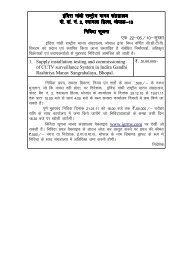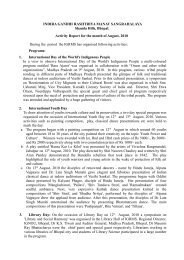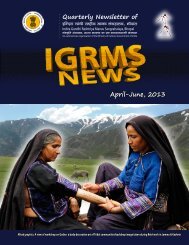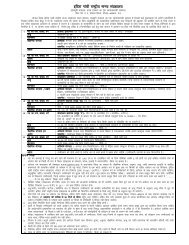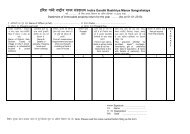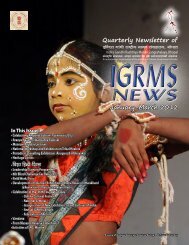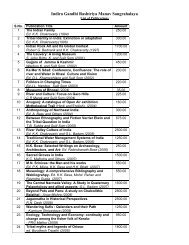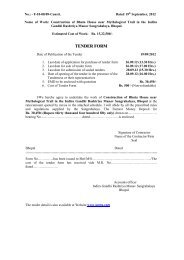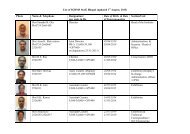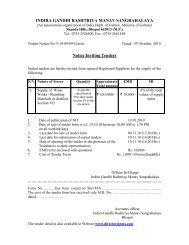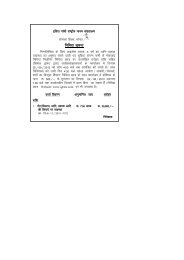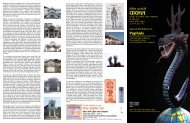Indira Gandhi Rashtriya Manav Sangrahalaya (National ... - IGRMS
Indira Gandhi Rashtriya Manav Sangrahalaya (National ... - IGRMS
Indira Gandhi Rashtriya Manav Sangrahalaya (National ... - IGRMS
Create successful ePaper yourself
Turn your PDF publications into a flip-book with our unique Google optimized e-Paper software.
<strong>Indira</strong> <strong>Gandhi</strong> <strong>Rashtriya</strong> <strong>Manav</strong> <strong>Sangrahalaya</strong> 283<br />
Museum. For researchers engaged in architecture, tribal art and religion,<br />
conservation techniques, graphic art, as well as administrative planners the Tribal<br />
Habitat of <strong>IGRMS</strong> is a laboratory for various practical experience.<br />
Taking note of the success of ‘Tribal Habitat’ experience, more and more<br />
similar open-air exhibitions were created to depict the life and culture of Indian<br />
coastal communities, the people living in desert region of western India, and also<br />
the lengthy stretch of Himalayan region. In developing the exhibits in these<br />
exhibitions, methodology adopted was similar to that of the Tribal Habitat<br />
Exhibition.<br />
Coastal Village open-air exhibition set up in about 20 acres land, represents<br />
dwelling units and related material cultural objects from different coastal parts of<br />
India; viz. Gujarat, Kerala, Tamilnadu, Andhra Pradesh and Orissa. These are<br />
typical traditional house-types, representing lifestyles and cultural identities of<br />
Indian coastal communities. Some eco-friendly structures exhibited in this complex<br />
reflect the socio-economic situation of inhabitants, like the ‘Arapura’ (wooden<br />
cottage), and ‘Palliyodam’ (snake-boat) from Kerala, are the main attractions for<br />
visitors.<br />
Desert Village open air exhibition represents typical dwelling-types from<br />
Jaisalmer in Rajasthan. A dwelling complex of Rajputs in this exhibition highlights<br />
the process and degree of their adaptation with environment. Various ethnographic<br />
objects displayed inside the dwelling units depict their life-ways and subsistence<br />
strategies.<br />
One of the interesting and unique items in the Himalayan Village is the typical<br />
stone building - Kothi – a dwelling complex from Shimla re-erected in the campus.<br />
The imposing entrance gate known as Parol or Paraud constructed to protect and<br />
lend beauty to the courtyard is a reminder of the culture and ecology of the<br />
terrain of the Himalaya region. The Choukat, another house-type from Uttaranchal<br />
is said to be earthquake resistant variety.<br />
The <strong>IGRMS</strong> is fortunate to have about 30 odd painted rock caves within its<br />
campus. These have been transformed into an open-air exhibition titled Rock<br />
Art Heritage. Perhaps <strong>IGRMS</strong> is one of the few Museums in the world which has<br />
shelters of the Prehistoric Man in its premises with paintings drawn by the prehistoric<br />
dwellers. These are valuable assets not only for researchers but also for<br />
inquisitive general visitors to the <strong>IGRMS</strong> campus.<br />
The Exhibition Mythological Trail depicts compositions as reflected in myths<br />
and legends of various folk and tribal communities. These are crafted in different<br />
media of terracotta, wood, stone, iron etc. Crafts of various artisan groups,<br />
incarnations of folk deities and traditional paintings form the main attraction of<br />
the exhibition. A 12 ft. tall iron gate with decorative carvings, representing the<br />
origin and technology of iron-smithy (done by Lohars from Bastar), forms an<br />
imposing structure of this exhibition.



